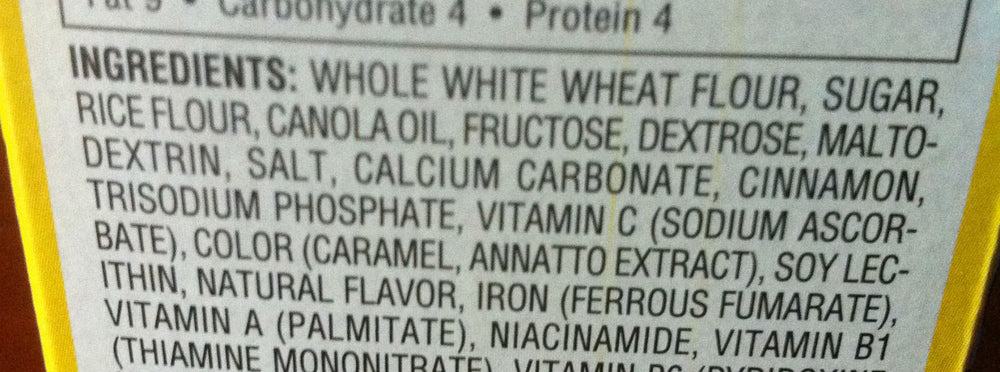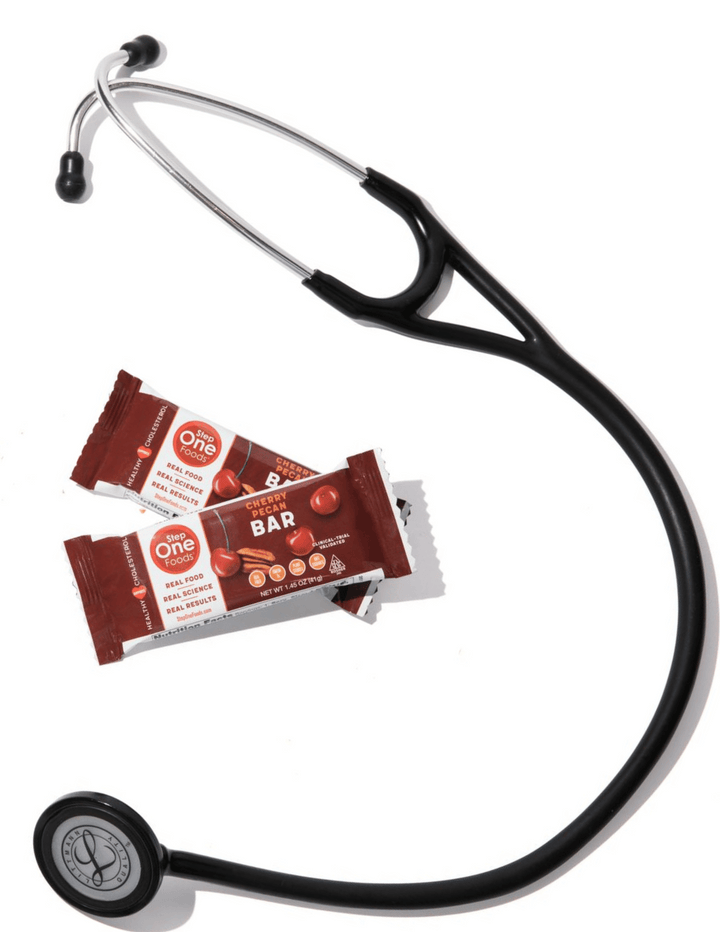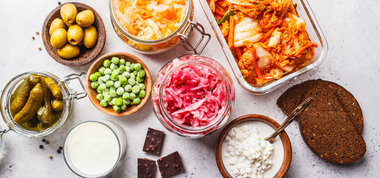Can you trust the ingredient panel on food packaging? Most doctors don't.

Misleading information on food packaging is one of the things I am most passionate about and one of the reasons that I started Step One Foods. I also spearheaded an effort within the American College of Cardiology to send a letter to the FDA asking them, among other requests, to stop the practice of ingredient list manipulation. It was only one letter - but it did come from an organization representing over 52,000 health care professionals.
The fact that food labeling has become nothing but a ruse is why you won't find lots of check marks and sanctioned claims all over Step One's packaging. Although, legally, we could plaster our boxes with them, our products are not about claims. They are about results.
Deceptive labeling is one of the major factors that has lead to the epidemic of chronic disease in the United States. My patients, and millions around the country, are trying to make the right choices, but often fall prey to clever marketing. At best, people are being led to believe that what they're eating is better for them than it actually is. At worst, they are being completely manipulated and duped. Even by the most regulated section of a food's packaging - the ingredient panel.
What's an ingredient panel/label?
The ingredient panel/label is a highly standardized list of ingredients found on the side or back of a food's package. It is presented in accordance with FDA guidelines that cover everything from which ingredient names should be used to the font size of the print. And the FDA is not kidding around. Failure to list an ingredient, or failure to list it properly, places a food company at risk of facing serious sanctions and stiff fines. So if you’re going to find truth anywhere on the package, it should be here. And many of us have heard the advice to always look at the ingredient list, especially the first five ingredients, to assess the quality of the foods we are purchasing.
Unfortunately, despite the FDA’s best intentions, even the ingredient list is being manipulated by manufacturers.
But before you can recognize the deception, you need to know something about the rules.
According to FDA rule 21 CFR 101.4(a), ingredients must be listed “in descending order of predominance by weight”, meaning that “the ingredient that weighs the most is listed first, and the ingredient that weighs the least is listed last”.
What is ingredient splitting?
Here’s the list of ingredients for PLANTERS HONEY ROASTED PEANUTS:
PEANUTS, SUGAR, HONEY, CORN SYRUP, PEANUT AND/OR COTTONSEED OIL, SALT, FRUCTOSE, CORNSTARCH, XANTHAN GUM
The list tells you that when you’re eating these peanuts, you’re ingesting more nuts than xanthan gum. So far so good.
But unless you were paying attention, you probably missed the fact that Planters employed ingredient “splitting” to manipulate the appearance of the list.
Look back at Planter’s ingredient list again. It contains 4 separate added sugars (sugar, honey, corn syrup and fructose). These sugars may technically be distinct and each was obviously used to make the product, but their only role is to add sweetness and from a nutrition perspective they are basically interchangeable. So why did Planters use four sugars not one? To ensure that an added sweetener didn't end up ahead of the peanuts in the ingredient panel.
What is ingredient combining?
There’s even more to FDA rule 21 CFR 101.4(a). If an ingredient has sub-ingredients, those sub-ingredients are listed in parentheses, and also in descending order of predominance by weight for the ingredient’s composition. This is meant to help deal with standard ingredient items such as chocolate or dried cranberries which naturally contain more than one component.
Now take a look at the list of ingredients for KIND CINNAMON OAT CLUSTERS WITH FLAX SEEDS:
WHOLE GRAIN BLEND (OATS, BROWN RICE, BUCKWHEAT, AMARANTH, MILLET, QUINOA), DRIED CANE SYRUP, FLAX SEEDS, CHICORY ROOT FIBER, CANOLA OIL, MOLASSES, CINNAMON, SEA SALT, BROWN RICE SYRUP, VITAMIN E (TO MAINTAIN FRESHNESS).
The cereal is made mostly out of a blend of whole grains, and the blend is made up of more oats than quinoa. Again, fairly straightforward.
Or is it?
Something made of many things will weigh more than any one of its components alone - and manufacturers use this to their advantage. In essence, they create novel multi-ingredient items that were never envisioned by the FDA. Known as ingredient "combining," this allows more desirable-sounding items to float to the top of the list.
Take a look at KIND’s ingredient list again. “Whole grain blend” definitely sounds healthy and it makes you feel good to find it as the first item listed. However, this "whole grain blend" is a completely made up term, and it is reasonable to expect that if each of the components in the “whole grain blend” were enumerated separately, dried cane syrup (a sneaky name for sugar) could float to the top.
The result
Ingredient splitting and combining is a rampant industry practice. And it makes knowing what you’re eating almost impossible to figure out - by design.
Just look at the ingredient list in KELLOGG’S® SPECIAL K® STRAWBERRY PROTEIN MEAL BAR:
COATING (SUGAR, PALM KERNEL AND PALM OIL, MILK PROTEIN ISOLATE, NONFAT YOGURT POWDER [CULTURED WHEY PROTEIN CONCENTRATE, CULTURED SKIM MILK, YOGURT CULTURES; HEAT-TREATED AFTER CULTURING], COLOR ADDED, SOY LECITHIN, NATURAL AND ARTIFICIAL FLAVOR), SOY PROTEIN ISOLATE, SOLUBLE CORN FIBER, STRAWBERRY FLAVORED FRUIT PIECES (SUGAR, CRANBERRIES, CITRIC ACID, NATURAL STRAWBERRY FLAVOR WITH OTHER NATURAL FLAVORS, ELDERBERRY JUICE CONCENTRATE FOR COLOR, SUNFLOWER OIL), CORN SYRUP, FRUCTOSE, INULIN, SUGAR, RICE, WHOLE GRAIN WHEAT, SOYBEAN AND PALM OIL WITH TBHQ FOR FRESHNESS, CONTAINS 2% OR LESS OF DEXTROSE, CALCIUM CARBONATE, GLYCERIN, SORBITOL, WHEAT BRAN, SALT, SOLUBLE WHEAT FIBER, SOY LECITHIN, VITAMIN C (ASCORBIC ACID), MALT FLAVOR, CITRIC ACID, STRAWBERRY JUICE CONCENTRATE, VITAMIN E (ALPHA TOCOPHEROL ACETATE), XANTHAN GUM, NIACINAMIDE, BHT FOR FRESHNESS, ZINC OXIDE, REDUCED IRON, NATURAL AND ARTIFICIAL FLAVOR, VITAMIN B6 (PYRIDOXINE HYDROCHLORIDE), VITAMIN B1 (THIAMIN HYDROCHLORIDE, THIAMIN MONONITRATE), VITAMIN A PALMITATE, VITAMIN B2 (RIBOFLAVIN), WHEAT STARCH, PARTIALLY DEFATTED PEANUT FLOUR, ALMOND FLOUR, VITAMIN B12, FOLIC ACID, VITAMIN D3.
If you missed the fact that added sugars are listed 6 times, and that there are no actual strawberries in the bars, don’t feel bad.
That’s the point.
Why Step One Foods is different
At Step One we refuse to play these games. Every single ingredient in every Step One product was chosen for its health promoting properties, in amounts needed to achieve clinically meaningful levels of whole food fiber, omega 3 fatty acids, antioxidants and plant sterols. We don’t deceptively combine or split ingredients. Because we don’t have to.
You can trust Step One Foods.

Tested & Proven Results.
- Cardiologist formulated
- Supported by over 500 publications
- Clinically-proven, in a double-blind randomized trial with Mayo Clinic and The University of Manitoba
80% of participants lowered their cholesterol in just 30 days. With just two servings per day, Step One Foods offers a proven-effective way to naturally lower LDL (bad) cholesterol.
Get heart health tips and articles like this, delivered right to your email.
New articles every week.
You may also like...

You don’t need to avoid foods with cholesterol…except for these




